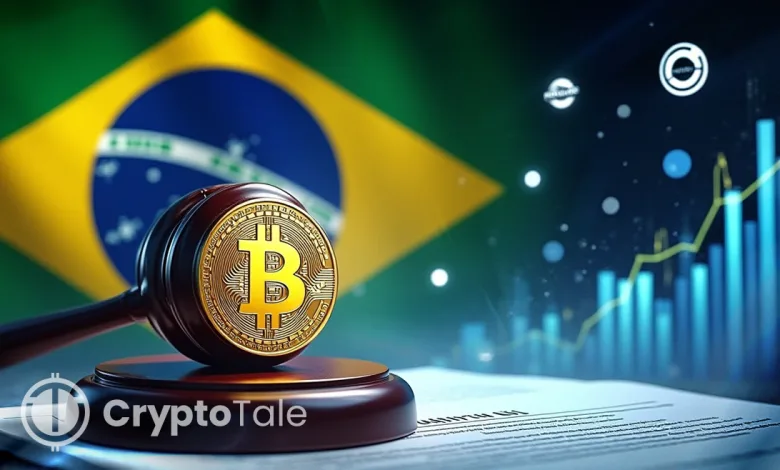Brazil Enforces $7 Million Crypto Capital Rule and FX Limits

- Brazil sets $7 million capital rule and FX limits to tighten crypto market oversight.
- The new framework mandates the local registration for all domestic and foreign VASPs.
- Stablecoin transactions are now classified as FX operations under the new central bank law.
Brazil’s central bank has issued crypto regulations, tightening control over one of Latin America’s fastest-growing digital asset markets. The framework mandates high capital requirements of up to $7 million, imposes foreign exchange transaction limits, and requires both local and international crypto firms to register under the new licensing regime starting February 2, 2026. The move aims to align the nation’s crypto oversight with global financial standards set by the U.S. and European Union.
Central Bank Introduces New Licensing Regime
Under the rules, crypto businesses must register as Sociedades Prestadoras de Serviços de Ativos Virtuais (SPSAVs), also known as Virtual Asset Service Providers (VASPs). The Banco Central do Brasil will oversee their authorization and compliance. Firms are divided into three categories, which are intermediaries, custodians, and brokerages, each subject to separate operational standards.
These providers must establish strong cybersecurity systems, anti-money-laundering (AML) controls, and risk management frameworks. The central bank’s goal is to integrate crypto activity into the nation’s broader financial surveillance network, ensuring transparency and accountability.
International platforms serving Brazilian users must open a legal entity within Brazil. They are required to migrate their local operations to that entity during a nine-month transition window or face prohibition from serving domestic clients. This provision seeks to curb offshore dominance while improving regulatory enforcement.
$7 Million Capital Raises Market Entry Bar
Depending on a company’s size and function, firms must maintain between 10.8 million and 37.2 million reais ($2 to $7 million) in capital reserves. The new rules are meant to make the financial system stronger during market ups and downs and to keep customers’ money safe.
But the required amount is much higher than the 1 to 3 million reais suggested earlier, worrying smaller startups. Many in the market fear that the high costs could push out small players and give more control to big, well-funded companies. Still, officials argue that larger capital reserves are needed to prevent bankruptcies and build trust in the digital finance sector.
The policy also supports Brazil’s ongoing digital transformation, including the Digital Real (DREX) project and updates to digital banking laws. By holding crypto companies to the same standards as regular banks, regulators hope to blend innovation with financial stability.
FX Controls Extend to Stablecoins
Another major provision brings crypto-related transactions under Brazil’s foreign exchange and capital control laws. The framework classifies the purchase, sale, or transfer of stablecoins as foreign exchange operations.
This classification extends to cross-border payments, crypto-to-fiat exchanges, and even transfers to self-custody wallets. Authorized institutions such as banks and registered VASPs may conduct these transactions, but must observe strict caps.
Each international transfer is limited to $100,000, and firms must submit monthly reports to the central bank detailing the transaction’s purpose, participants, and value. The bank stated these disclosures are designed to prevent illicit flows, close arbitrage gaps, and incorporate crypto movement data into national economic statistics.
The rules also restrict the use of physical money in crypto trades. VASPs cannot handle cash, domestic or foreign, or use foreign banknotes to buy or sell digital assets. This measure seeks to eliminate potential loopholes for money laundering while steering transactions toward auditable digital channels.
The regulations coincide with Brazil’s rising stablecoin activity and aim to align local practices with global anti-money-laundering and counter-terrorism standards. The inclusion of stablecoins under FX law positions Brazil ahead of many regional counterparts in regulating digital asset flows within a monetary policy framework.
Related: Brazil’s VERT Launches $130M Tokenized Credit on XRP Ledger
Compliance and Regional Impact
Starting February 2, 2026, firms will have nine months to meet compliance standards, including registration, capital adequacy, AML documentation, and transaction transparency. Those who fail to comply risk suspension or permanent exclusion from the Brazilian market. The central bank confirmed it will conduct regular audits to ensure ongoing adherence.
While industry reactions are mixed, analysts note the measures create long-awaited legal clarity. Larger institutions may benefit from the enhanced credibility and structured oversight, while smaller players could face operational challenges due to cost burdens.
The regulatory change places Brazil among the leading Latin American nations moving toward institutional-grade crypto supervision. By merging fintech compliance with central bank oversight, the country is shaping a hybrid regulatory model that balances innovation with economic stability.
Meanwhile, Brazil’s new crypto framework is among a broader trend of tightening policy across Latin America. Capital thresholds, FX-linked limits, and local registration rules are a move toward transparency and integration within the global financial system.





